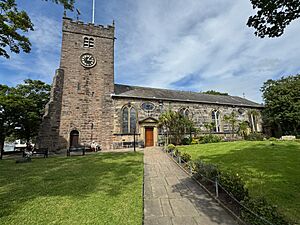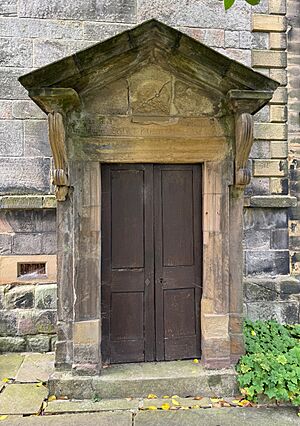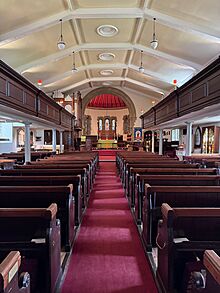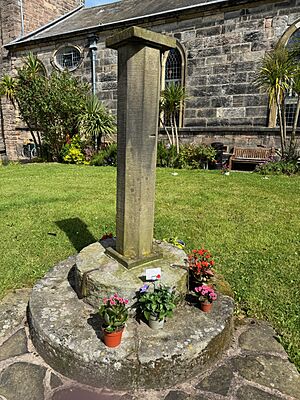St Chad's Church, Poulton-le-Fylde facts for kids
Quick facts for kids St Chad's |
|
|---|---|

St Chad's Church from the south
|
|
| Lua error in Module:Location_map at line 420: attempt to index field 'wikibase' (a nil value). | |
| OS grid reference | SD 3482 3945 |
| Location | Poulton-le-Fylde, Lancashire |
| Country | England |
| Denomination | Anglican |
| History | |
| Status | Parish church |
| Dedication | Chad of Mercia |
| Architecture | |
| Functional status | Active |
| Heritage designation | Grade II* |
| Designated | 23 September 1950 |
| Architect(s) | Paley and Austin (1868) J. S. Crowther (1881–83) |
| Specifications | |
| Length | 113 feet 6 inches (34.59 m) (internal) |
| Materials | Red sandstone with grey ashlar |
| Administration | |
| Deanery | Poulton |
| Archdeaconry | Lancaster |
| Diocese | Blackburn |
| Province | York |
St Chad's Church is an Anglican church located in Poulton-le-Fylde, Lancashire, England. It is a busy parish church within the Diocese of Blackburn. The church is recognized as a special building, listed as Grade II* on the National Heritage List for England.
There has been a church on this spot since at least the 11th century. It might even have been there before the Norman Conquest of England in 1066. The church's tower was built in the 1600s. Most of the rest of the building was greatly updated in the 1700s. However, some parts of the very first church still remain. More changes and additions were made in the 1800s, 1900s, and 2000s.
After the Norman Conquest, the area of Poulton was given to Lancaster Priory. Later, in the 1400s, King Henry V gave the church to Syon Monastery. When monasteries were closed down in the 1500s, the church went back to the Crown. For many centuries, the Hesketh/Fleetwood family had the right to choose the parish priest.
The church is made of red sandstone with grey stone ashlar on the outside. It has a main hall (called a nave), a special area for the altar (the chancel), a square tower, and a round end (an apse). Inside, you can see a Georgian staircase, an old Jacobean pulpit, and special family pews. There are eight bells in the tower. Outside, you can still see parts of an old stone preaching cross.
Contents
History of St Chad's Church
There was likely a church on the site of St Chad's even before the Norman Conquest in 1066. Written records show a church here from 1094. The Domesday Book of 1086 mentioned three churches in the area, but did not name them. It is believed that St Chad's was one of them. The church is named after Chad of Mercia, a saint from the 600s. This suggests it was built a very long time ago.
Early Ownership and Changes
The first clear record of Poulton's church is from 1094. After the Norman Conquest, the Poulton area was given to a knight named Roger the Poitevin. In 1094, Roger started the Benedictine Lancaster Priory and gave the church and land at Poulton to it. Roger was later sent out of the country, and his lands went back to the King.
In 1194, King Richard I gave the Poulton area to Theobald Walter, 1st Baron Butler. Theobald thought he should also have the right to choose the priest for Poulton. However, in 1196, he gave up this right, and it stayed with the monks of Lancaster.
In 1275, the Lancaster monks appointed a vicar to the church. In 1291, St Chad's was valued as one of the richest churches in Lancashire. In 1345, repairs were ordered for the chancel (the area around the altar).
From Monasteries to the Crown
In 1415, King Henry V closed down monasteries that were controlled by religious groups in other countries. St Chad's Church then went back to the King. Henry V later gave it to Syon Monastery in Middlesex.
During the English Reformation in the 1500s, St Chad's became an Anglican parish church. A parish is a local church area. Originally, St Chad's parish covered Poulton and several nearby villages. Syon Monastery was closed in 1539, and St Chad's once again returned to the Crown. Later, Queen Elizabeth I gave the right to choose the priest to John Fleetwood. The Fleetwood family kept this right until the early 1900s.
Building Updates Over Centuries
The current tower of the church was built sometime in the 1600s. In 1751, the church had a big renovation. It was once thought that the old church was completely torn down, but we now know that the "new" building still uses the outer walls of the older structure. These original walls were made of red sandstone and covered with grey ashlar. The main part of the church (the nave) was rebuilt in 1753.

By the 1800s, the churchyard was very full. It was hard to find space for new burials. In 1884, the churchyard was closed for burials, and a new cemetery opened in the town.
A round, Norman-style apse was added to the church in 1868. This work was done by architects Paley and Austin. The vicar at the time, Rev. Thomas Clarke, paid for this addition. More changes happened in 1881–83, including a new baptistery and choir stalls. In 1955, the church was renovated again, and some old furnishings were removed. A small extension was added in 2005.
The right to choose the priest for Poulton, which the Fleetwood family had for about 400 years, was sold in 1934 to the Diocese of Blackburn.
Architecture of St Chad's
Outside the Church
The outside walls of St Chad's Church are made of red sandstone with grey stone details. The roofs are made of slate. The church has a main hall (the nave), a square tower at the west end, and a chancel with a rounded end (an apsidal sanctuary) at the east. There is also a small room for the clergy (a vestry) at the south-east corner.
The tower at the west end was built in the early 1600s. It has a castellated top, like a castle. It is built from rough stone and has strong supports called buttresses. There are four pointed tops called pinnacles on the corners. The tower has openings with louvres for the bells and clock faces on the north and south sides.
A small stone entrance on the south side leads to the Fleetwood family burial vault. The doorway has an old inscription from 1699. There are two other doorways on the south side of the nave. These have been restored and feature Tuscan columns and triangular tops called pediments. Above these doorways are oval windows, which add a touch of elegance. The church also has large, round-headed arched windows with decorative stone patterns.
Inside the Church
Inside, the main hall (nave) is about 93 feet long and 36 feet wide. The chancel, including the apse, is about 20 feet long. The tower area is about 12 feet by 12 feet. The church ceiling has shallow, curved designs.
There are upper levels, called galleries, on the north, west, and south sides. You can reach them by a Georgian staircase in the north-west. The north and south galleries are supported by simple columns and have special box pews from 1752.
The Stained glass windows were made between the late 1800s and mid-1900s. Some were created by local designers Shrigley and Hunt. The pulpit, where the priest gives sermons, was built in 1955. It was made using parts of a 17th-century pulpit and has old designs and an inscription from the Book of Isaiah.
In the south-west corner of the nave is a choir vestry. It was originally built as a baptistery. Its screen is made of carved oak. It was created in 1883 from part of the Fleetwood family's special box pew. This wood is carved with family symbols like a double-headed eagle and a griffin. The door for the screen comes from another family's pew and has a carving of a goat's head from 1636.
Six special diamond-shaped paintings, called hatchments, hang in St Chad's. They show the coats of arms of Hesketh-Fleetwood family members from the 1700s. These were painted for their funerals and then hung in the church.
The tower holds a ring of eight bells. Five of these bells were made in 1741. They were rehung in 1908. Another bell was recast in 1865. In 1919, the church bells were still used to signal the town's curfew between September and March. Two more bells were added in 1937.
St Chad's Churchyard
To the south of the church, you can see the remains of a stone preaching cross. This cross was originally on Poulton's boundary. It was a resting place for people traveling long distances to bury their loved ones at St Chad's. Only the two circular steps where the cross stood remain today. The cross itself has been replaced by an eight-sided pillar. This pillar was used as a sundial until the early 1900s. The steps now serve as a memorial in a small garden of remembrance. The churchyard is known for its beautiful display of crocuses and other flowers in early spring.
Even though the churchyard stopped new burials in 1884, the ashes of cremated bodies have been placed in a small area west of the church since the 1950s. Some old gravestones were laid flat to create paths in the churchyard in 1973. There are still a few standing gravestones and several table tombs. To the south-east, there is a gravestone for Edward Sherdley (who died in 1741). This stone has carvings of a skull and crossbones and an hourglass. Locals sometimes call it the "pirate's grave."
The north side of the churchyard is next to Ball Street, and Church Street is on its west side. In the early 1900s, buildings lined both sides of these streets. When some of these buildings were taken down, it opened up the view of the churchyard's higher position.
St Chad's Today
St Chad's was officially recognized as a Grade II* listed building on September 23, 1950. This means it's a very important historic building. It is an active church in the Church of England, part of the diocese of Blackburn. The church is in the archdeaconry of Lancaster and the Deanery of Poulton. The church's area, called the benefice, includes Poulton, Carleton, and Singleton. The Rev. Martin Keighley became the vicar of St Chad's in 2000. The church also includes the Church of St Hilda of Whitby in Carleton.
See also
- Grade II* listed buildings in Lancashire
- Listed buildings in Poulton-le-Fylde
- Market Place
- List of works by J. S. Crowther
- List of ecclesiastical works by Paley and Austin





